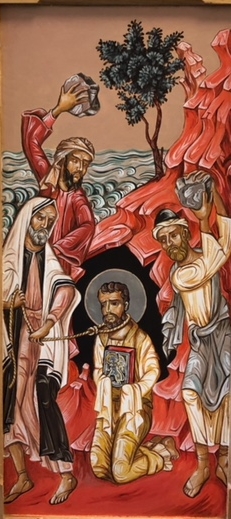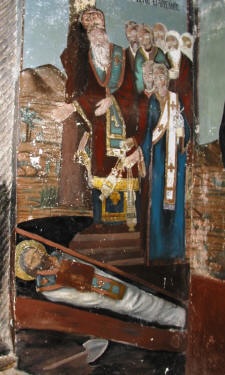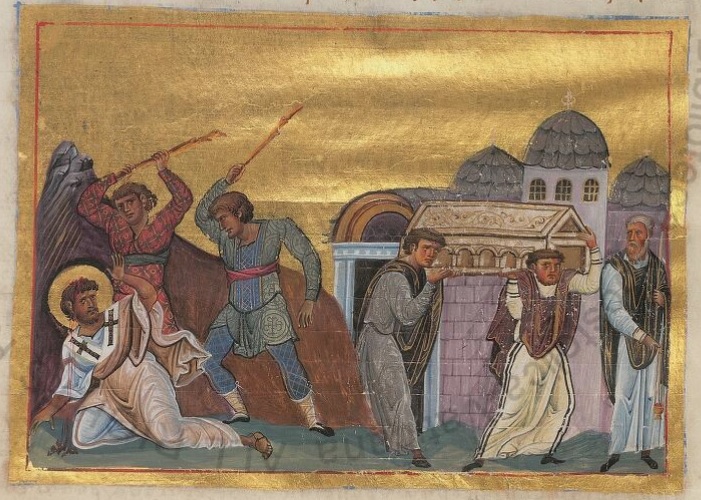Anchor Bible Report 15: The Apocryphal Lives of the Companions of Paul
As my readers on Twitter are aware, I have been posting reports on my latest project: an introduction to Christian apocrypha for the Anchor Yale Bible Reference Library. I am back to the project after taking a month to complete the indices to More New Testament Apocrypha vol. 3, but I feel . . . disenchanted with Twitter lately and thought I would switch the forum for these reports to my neglected blog. There are no megalomaniacs or racists here, and no one to tell me how many characters I can use.
This past week I turned my attention away from the five “great” apocryphal acts and worked on some later acts focusing on the companions of Paul: Barnabas, Timothy, and Titus. I figured these texts would make a gentle re-entry into the project. All three main texts appear in MNTA 1 and have companion e-Clavis entries, so the scholarship should be up-to-date. Well, it’s been more difficult than I thought.

Joseph Barnabas appears in Acts as an “apostle” (14:14) and early recruit of the church in Jerusalem. He is introduced as a Jew from Cyprus who gave all of his money to the church (Acts 4:36–37). When Paul makes his first visit to the Jerusalem church, Barnabas comes to his defense (9:26–27) and then travels with Paul and John Mark until the group is divided (15:36–40)—Paul refuses to travel with John Mark because he had abandoned them in Pamphylia (13:13). Barnabas and John Mark sail away to Cyprus and Paul moves on to Syria and Cilicia.
The corpus of apocryphal Barnabas texts includes the Acts of Barnabas (translated by Glenn Snyder in MNTA 1:317–36 based on the edition in Lipsius-Bonnet, AAA, 2.2:292–302; a French translation by Enrico Norelli appears in EAC 2:617–42). Bonnet used six Greek manuscripts and readings from two published Latin manuscripts (described vaguely in MNTA as recension n and c, but now fully documented on e-Clavis). Of the Greek manuscripts, one seems to have the superior text (Paris, BNF, gr. 1470; 9th cent.); another seven unassessed manuscripts are listed on Pinakes (and e-Clavis), one of them (Cambridge, University Library, Add. 4489; details HERE) is a palimpsest dating from the eighth century. As for the Latin, more than 60 sources are known, and it is, in turn, summarized in the Golden Legend 81. Several copies exist also in Church Slavic, but only one has been published to date. Clearly this is a text that demands a new edition. The text is as much an acts of John Mark as an acts of Barnabas; John Mark is the narrator and he reveals information about his early life and accompanies Barnabas in his travels along the Cilician coast and throughout Cyprus.
The text seems to have been composed on Cyprus in the late fifth or early sixth-century, when sources describe the discovery of the tomb of Barnabas, who was found buried with a copy of the Gospel of Matthew written in the evangelist’s own hand. This story was used to justify the continued independence of the church of Cyprus (Theodorus Lector, Hist. eccl. 530; Isidore of Seville, Chron. 112). This discovery is reflected in Barnabas’s martyrdom and burial at the end of the text (8:1–4). A group of Jews in Salamis bind him with a rope and drag him through the city; then they burn his body and encase the remains in lead with the intention of throwing them into the sea. But John Mark comes at night, takes the remains and puts them in a cave along with a scroll of Matthew that Barnabas used for preaching and as an instrument of healing. The text also tries to answer some lingering questions from Acts, such as why John Mark abandoned Paul (“the Holy Spirit did not permit me”; 3:2), and the precise nature of their disagreement (“His great pain with me was due to my keeping the complete parchments in Pamphylia”; 4:5). In addition, the parting between Paul and Barnabas is presented as more amicable, with Paul saying the Lord appeared to him and told him to let Barnabas go on to Cyprus with John Mark, and he must go to Jerusalem (5). Another interesting aspect of the text is the re-appearance of Elymas (from Acts 13:6–12), who interferes with Barnabas’s mission in Cyprus and orchestrates the apostle’s death.

The second Barnabas text is the Encomium on Barnabas is attributed to Alexander “the Monk” of Cyprus, commissioned from the author by the “guardian” of the shrine of Barnabas in Salamis. The text has not yet been translated into English, but a detailed summary is provided by Kelly Holob on e-Clavis. An edition based on eight manuscripts has been prepared by Peter van Deun (1993); a number of additional manuscripts are listed on Pinakes (and e-Clavis). This text also seems to be from fifth/sixth-century Cyprus and provides a more detailed account of the discovery of Barnabas’s tomb. It seems to be the chief resource about the apostle circulated by the Church of Cyprus. According to Alexander, the location of Barnabas’s tomb was revealed by Barnabas in a dream to the fifth-century bishop of Salamis, Anthemios, who is urged by Barnabas to journey to Constantinople and argue for the continued independence of the Church of Cyprus. The copy of Matthew found with Barnabas brings esteem to the apostle’s mission and is used as justification for the church’s position. Anthemios successfully argues his case and the gospel is said to be in the palace of the emperor “to this day” and is read from on the Great Thursday of Holy Week. Anthemios was commanded to build a church for Barnabas, where his coffin was interred and where miracles occurred. Currently a mausoleum sits beside the Ayios Barnabas (Monastery of Barnabas, now a museum; brief history given on Wikipedia) in Famagusta and visitors can descend a staircase leading to a cave below that houses the empty tombs of both Barnabas and Anthemios; the current location of their remains is unclear. The apocryphal traditions about Barnabas are reflected in icons of the apostle, which typically depict him holding his copy of Matthew’s gospel.
Encom. Barn. had a second life as part of another text: the Acts of Bartholomew and Barnabas. Here Alexander’s account is preceded by a few details about the apostle’s early life (he is said to be of the tribe of Levi, and descended from the prophet Samuel). This text also was edited by Peter van Deun (based on five Greek manuscripts) and has not yet been translated into English; Kelly Holob presents a summary in her e-Clavis entry.
In the canonical Acts, the departure of Barnabas is followed by Paul’s first encounter with Timothy in Lystra (Acts 16:1–5). Timothy is described as the son of a gentile father and Jewish mother, and Paul “had him circumcised because of the Jews,” though the reason is not made clear. Timothy is listed as coauthor of several of Paul’s letters (2 Cor, Phil, Col, and 1 and 2 Thess), and served as a mediator between Paul and his communities (1 Cor 4:17; 16:10; Phil 2:19). He is the recipient of two of the Pastoral Epistles, written to him, the texts say, while he was in Ephesus (1 Tim 1:3; 2 Tim 1:18). According to Eusebius, Timothy was the city’s first bishop (Hist. eccl. 3.4.5).

The Acts of Timothy was prepared for MNTA by Cavan Concannon (1:395–405) based on an edition by Claudio Zamagni (2007) using seven manuscripts; Zamagni also contributed a French translation of his own edition for EAC 2:395–405. A Latin edition was produced by Hermann Usener (1887) based on two witnesses; another 35 are known. The text is also extant in a summary by Photius (Bib. cod. 254), two Greek epitomes (not mentioned in MNTA 1 but recently added to the e-Clavis page), and a Latin epitome by Vincent de Beauvais (Speculum historiale 11.38). Like Acts Barn., this text seems to be a local composition, written to celebrate the church of Ephesus and in particular to elevate Timothy—here called the “first patriarch of Ephesus” and an “apostle”—to a level of importance equal to the apostle of John who is traditionally associated with the city. The Latin tradition attributes authorship to Polycrates, bishop of Ephesus at the end of the second century (Eusebius, Hist. eccl. 5.23–24), but likely the text was composed by another resident of the city in the fourth or fifth century. Timothy is not long in Ephesus before the arrival of John by shipwreck—as told, the author states (7), in the writings of Irenaeus, though no such thing occurs in any known writings of Irenaeus; it is, however, reported in the Acts of John by Prochorus and the Memorial of John, both of which are featured in MNTA 3. Acts Tim. is noteworthy also for containing an account of the composition of the canonical Gospels. While in Ephesus, the disciples bring John the stories of Jesus told to them by the apostles, and John arranges them into the three gospels of Matthew, Mark, and Luke, before writing his own to fill in “the things that were not mentioned” (8–10). Timothy’s leadership in Ephesus is restored after John is exiled to Patmos by Domitian but he soon perishes at the hands of club-wielding participants of the Dionysian Katagogia festival. Three days later, on January 22, he dies of his injuries and his body is interred in a cave on Mount Pion. One group of Greek manuscripts adds the detail that Timothy’s body was transferred to the Church of the Apostles in Constantinople and placed in the altar alongside Andrew and Luke. Other sources report that this removal occurred under the reign of the emperor Constantius in 356 CE (Jerome, Chron. sa. 356–57; Philostorgius, Eccl. hist. 3.2; Paulinus of Nola, Natalicium (19.329); and others).
Two other accounts of Timothy exist, both drawing on Acts Tim. The first is the Hypomnema by Symeon Metaphrastes, which exists in over 90 manuscripts but has yet to be published in a modern language (indeed this is the case for all of Symeon’s Hypomnema). However, a summary is available on e-Clavis. Symeon likely drew on another Hypomnema by Nicetas of Paphlagonia but I have not yet been able to obtain the only published edition—a work by Russian scholar Vasily Latyšev (1917). Complicating the work on Hyp. Tim. is that it is presented in CANT in two separate entries: as Hyp. Tim. (CANT 296) and under the title “Commentarius” (CANT 297), which is the Walters “Imperial” Menologion, created in the eleventh century (available online HERE). But the two texts are largely the same, with the Commentarius mostly lacking a few chapters. Hyp. Tim. expands the account of Timothy’s life and martyrdom from Acts Tim., adding such details as the name of his mother (Lois) and grandmother (Eunice). Based on 1 Tim 5:23, the author says that that Timothy had “frequent ailments” and a “weak stomach.” The martyrdom of Timothy is mentioned also in the Golden Legend (121), but de Voragine’s brief account is very different: here Timothy is tortured and beheaded in Rome under the reign of Nero, along with a witness to the martyrdom, Apollinaris, who is beheaded also. The two may be confused here with Timothy and Apollinaris, third-century martyrs in Reims.
There is one more connection to mention between Timothy and apocrypha. Salvian of Marseille (5th cent.) was caught attributing some of his own work to the apostle Timothy. He argued in his own defense: “For in the case of every book we ought to be more concerned about the intrinsic value of its contents than about the name of its author. And therefore if the book is profitable reading and offers something to edify the reader, what does it matter whether or not it happens to satisfy someone’s curiosity about the name of the author?” (Ep. 9.3, cited from Baum 2013:48).

Finally, the third companion, Titus, is a gentile follower of Paul who accompanied him to Jerusalem with Barnabas (Gal 2:3–4). He appears again in 2 Cor as an intermediary between Paul and the Corinthian church (2 Cor 2:13; 7:6–7, 13-15; 8:6, 16, 23; 12:18). In 2 Tim 4:10 he has moved on to Dalmatia, and in the epistle to Titus he has been “left behind in Crete” to serve there as Paul’s representative and to “appoint elders in every town” (1:5). Eusebius says he was first bishop of Crete (Hist. eccl. 3.4.6). The Acts of Titus, the only known apocryphal account of his life, appears in MNTA 1:406–15 in a translation of the edition of François Halkin (1961). A French translation is given by Willy Rordorf in EAC 2:605–15. The text is extant in two versions called Menology 1 and Menology 2, each represented by two manuscripts. Both versions how signs of abbreviation and may rely on an older, more fulsome text but Menology 1 seems to be the better version. Likely the account was created in Crete. Previous scholars have seen its value primarily as a witness to the Acts of Paul from which it draws, weaving portions together with material from the canonical Acts. The text, attributed to Zenas the lawyer (mentioned in Titus 3:13), begins with Titus’s early life: he is an educated gentile nobleman from Crete dispatched to Jerusalem by his father to learn about Jesus (his story is similar to that of Clement from the Pseudo-Clementines). Titus becomes a follower of Jesus and witnesses many of the events of his life; after the ascension, he accompanies Paul on his preaching journeys. The text also introduces Rustillus, brother-in-law of Titus and proconsul of Rome. In gratitude to Titus for raising his dead son to life, Rustillus protects the Jews of Crete from harm during Vespasian’s siege of Jerusalem (5–7). At the end of the text, a church is built housing both Titus, who dies peacefully at the age of 94, and his sister Euphemia (9–11). The original church was built in Gortyn, but a new church was constructed in Heraklion in 828. When this church fell to the invasion of the Ottoman Turks in 1669, Titus’s relics were taken to Venice; the saint’s head was returned in 1966 and can be seen today at a new church in Heraklion (the Hagios Titus) built in the nineteenth century (for more information, see the Wikipedia entry). The text seems to have had limited appeal, given the paucity of the manuscript evidence and the lack of translations into other languages; nevertheless, the story of Titus’s foundation of the church of Crete is still disseminated in pamphlets at the Hagios Titus. The only other apocryphal text associated with Titus is the (Apocryphal) Acts of Titus, but it provides no details about his life and mission.
Uniting these three texts, besides the figure of Paul, is their narrow regional focus. They have had little life outside of their location of composition. There is no evidence of dispersion into Africa (in the Coptic-Arabic-Ethiopic apocryphal acts collections), nor in points east (Syria, Armenian, Georgia), except for the Church Slavic version of Acts Barn. They have received little attention also in scholarship, though there has been some interest recently in Acts Tim. from Meira Kensky and Jan Bremmer, due perhaps to the exposure it received in MNTA 1. Despite the paucity of sources, both primary and secondary, these texts still proved a challenge to cover for the Anchor Bible project—I don’t like leaving gaps. Hopefully the next few texts (additional “later” apocryphal acts) will be simpler.
Bibliography
Baum, Armin D. 2013. “Authorship and Pseudepigraphy in Early Christian Literature: A Translation of the Most Important Source Texts and an Annotated Bibliography.” Pages 11–63 in Paul and Pseudepigraphy. Edited by Stanley E. Porter and Gregory P. Fewster. Pauline Studies 8. Leiden and Boston: Brill.
Bremmer, Jan N. 2021. “Timothy, John and Ephesus in the Acts of Timothy.” Pages 215–39 in The Apostles Peter, Paul, John, Thomas and Philip with their Companions in Late Antiquity. Edited by Tobias Nicklas, Janet E. Spittler, and Jan N. Bremmer. Leuven: Peeters.
CANT=Clavis apocryphorum Novi Testamenti. Edited by Maurice Geerard. Corpus Christianorum. Turnhout: Brepols, 1992.
Deun, Peter van, and Jacques Noret, eds. 1993. Hagiographica cypria. Sancti Barnabae laudatio auctore Alexandro monacho. CCSG 26. Turnhout: Brepols; Leuven: University Press.
EAC=Écrits apocryphes chrétiens. Vol. 1 edited by François Bovon and Pierre Geoltrain. Bibliothèque de la Pléiade 442. Paris: Gallimard, 1997. Vol. 2 edited by Pierre Geoltrain and Jean-Daniel Kaestli. Bibliothèque de la Pléiade 443. Paris: Gallimard, 2005.
Halkin, Francois. 1961. “La légende crétoise de saint tite.” AnBoll 79: 241–56.
Kensky, Meira Z. 2019. “Ephesus, Loca Sancta: The Acts of Timothy and Religious Travel in Late Antiquity.” Pages 91–119 in The Narrative Self in Early Christianity: Essays in Honor of Judith Perkins. Edited by Janet E. Spittler. WGRWSup 5. Atlanta: SBL Press.
Latyšev, Vasilij V. 1917. “Syllog? Palaistin?s Syriak?s Hagiologias.” Pravoslavnij Palestinskij Sbornik 63.
Lipsius-Bonnet=Acta apostolorum apocrypha. Edited by Richard Adelbert Lipsius and Maximilien Bonnet. 2 vols. in 3. Leipzig: H. Mendelssohn, 1903; repr. Hildesheim: Olms, 1972.
Usener, Hermann. 1877. Natalicia regis augustissimi Guilelmi imperatoris Germaniae ab Universitate Fridericia Guilelmia Rhenana […] Insunt Acta S. Timothei. Bonn: Programme de l’université de Bonn.
Zamagni, Claudio. 2007. “Passion (ou Actes) de Timothée. Étude des traditions anciennes et édition de la forme BHG 1487.” Pages 341–75 in Poussières de christianisme et de judaïsme antiques. Études réunies en l’honneur de Jean-Daniel Kaestli et Éric Junod. Edited by Albert Frey and Rémi Gounelle. Prahins: Publications de l’Institut Romand des Sciences Bibliques, 2007.
